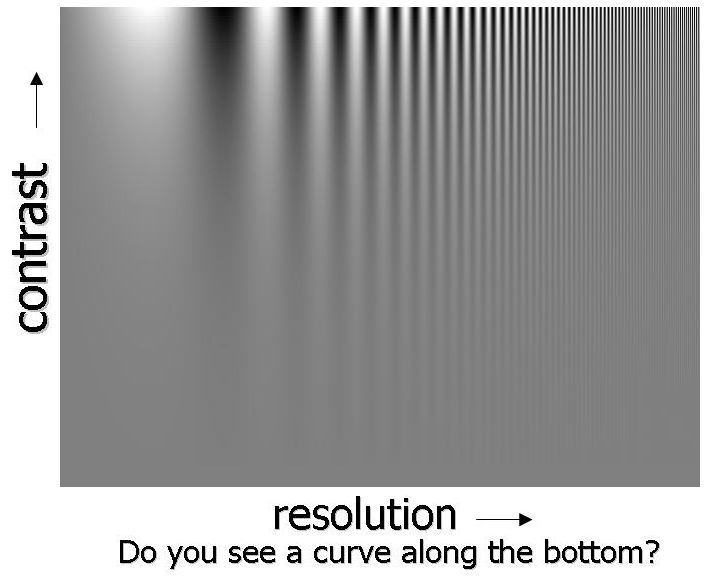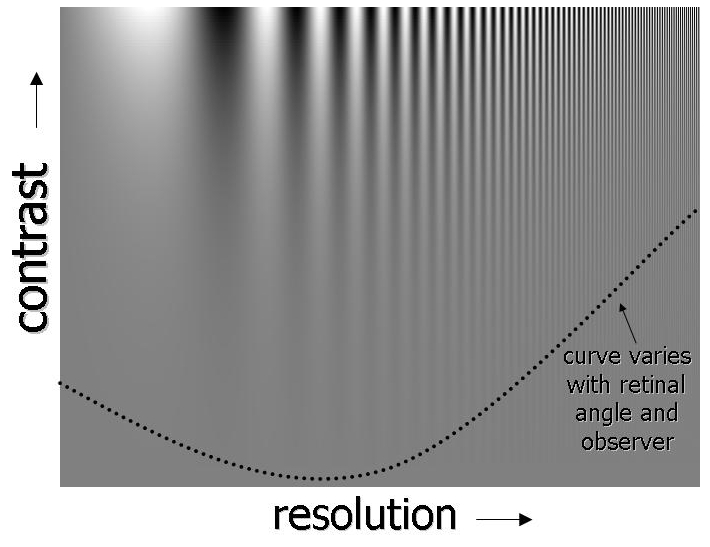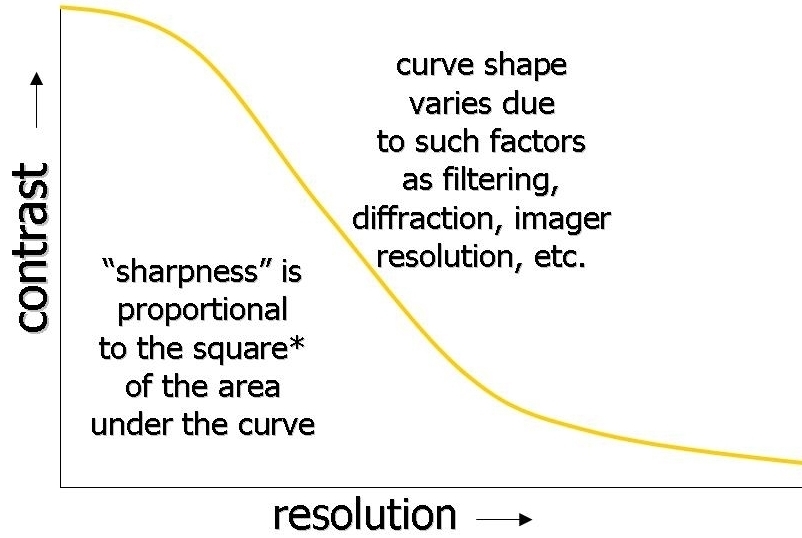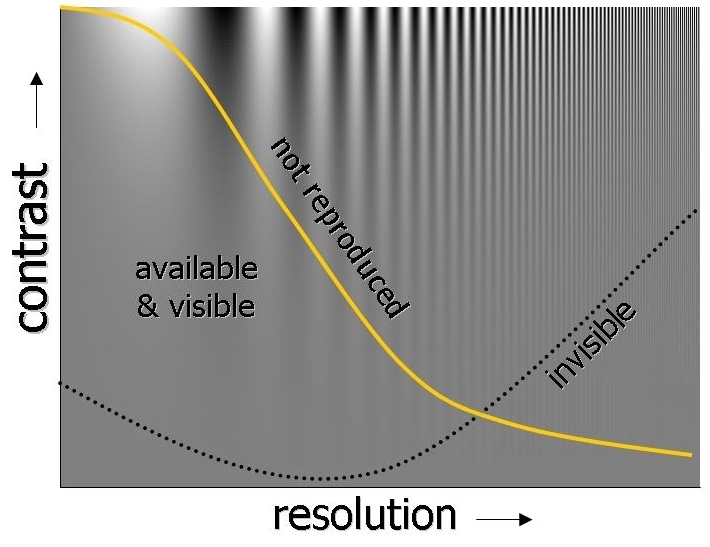Angry About Contrast

"Angry Man/Neutral Woman," copyright 1997, Aude Oliva, MIT, and Philippe G. Schyns, University of Glasgow
If you are looking at the above picture on a nominally sized screen at a nominal viewing distance, you probably see an angry man on the left. What’s an “angry man”? Me, when I think about technical descriptions of HDTV.
Think about it. Maybe you hear HDTV described as being 1080i or 720p. Maybe it’s 1920 x 1080 or 1280 x 720. Maybe it’s 2 megapixels or 1. An engineer who remembers such things as analog bandwidths might refer to 30 MHz or 37 MHz. Someone concerned with lenses might talk about 100 line-pairs per millimeter. Someone describing visual acuity, screen sizes, and viewing distances might offer 30 cycles per degree.
Someday, I’ll probably get around to explaining how all of those are related and how many of them are pretty much the same thing. But, when it comes to the sharpness perceived by viewers, they’re all pretty bogus because they’re all missing something of vital importance.
Of course, that isn’t the only silly spec. Look at “sensitivity,” or, one of my all-time favorites, “minimum sensitivity.” I just went to a web site of someone called an “expert” and found a sensitivity figure of 1 lux.
A lux is a unit of illuminance, lumens per square meter, how much light is falling on a surface. Let’s ignore the color of that light for now (though, in the real world, if the color didn’t match your camera’s receptors, you’d have a hard time taking pictures), and let’s also ignore what the light is hitting, all the glass between the scene and the image sensor, and what kind of picture will define sensitivity (all white? the tiniest hint of an image coming out of black? how tiny?).
The lens on the camera has an iris. The iris controls the amount of light passing through the lens. If all is perfect, f/8 allows half as much light to get through as f/5.6. So specifying lux without an aperture is pretty useless. But the camera probably also has controllable gain or amplification. You can boost the level of dark things in the picture by increasing gain. Six dB more gain is roughly twice the level. It also makes the pictures noisier or “snowier” (some would say “grainer,” but that’s the subject of another discussion), so, to compare camera sensitivities you need illuminance, aperture, and signal-to-noise ratio (at least that’s a start).
Now let’s get back to that HDTV resolution. Try to remember the first time you saw an HD picture or showed one to someone. Did you (or anyone else) exclaim, “Wow! Would you look at that resolution!” I doubt it. Perhaps the same person, wanting to read, says “Honey, could you increase the illuminance in this sector?”
No. What people sometimes exclaim upon seeing HDTV for the first time is “Look at how sharp it is!” But sharpness is absolutely not the same thing as resolution. Behold:

The image above is of a grating of alternating light and dark lines. The lines probably appear sharpest to you near the top, where the contrast is highest, and least sharp at the bottom, where the contrast is lowest. There is no difference in resolution between the top of the grating and the bottom.
Then there’s that curve. You probably see some sort of curve along the bottom, maybe in the shape of a lopsided smile. There is no such curve in the image. Your visual system is inserting the curve. It’s called a contrast-sensitivity function. I’ve added a curve to this image:

Everything below the dotted line would be invisible to an observer viewing the image at the appropriate angle and with that contrast-sensitivity function. Try moving closer to and farther from the screen to see how your own varies. Now here’s another curve, on the same axes and scale:

This one is called a modulation-transfer function (MTF) curve. Modulation, in this case, can be considered the change between black and white, i.e., how much contrast a system allows through. Everything has an MTF curve — a piece of cable, a lens, an amplifier, an imager, etc. I’ve noted above that the human visual sensation of “sharpness” is proportional to the square of the area under the curve. That was the view put forth by Otto Schade of RCA Laboratories. The asterisk is there because someone who has studied the work of Erich Heynacher of Zeiss says it’s just the area, not its square. Either way, you can’t have sharpness without contrast, and the greater the area under the curve, the greater the sharpness.
Someday soon, I hope to explain how something as simple as iris setting can significantly affect image sharpness (and I’m not talking about depth of field). Imager size is another big factor. You can have two 1920 x 1080 cameras that provide wildly different perceived image sharpnesses. That means resolution numbers, by themselves, are meaningless without contrast (or MTF) information. Surprise! There is a difference between a $100 camera and a $250,000 version.
Want to see how important contrast is? Take another look at that first picture:

Copyright 1997, Aude Oliva, MIT, and Philippe G. Schyns, University of Glasgow
The angry man is on the left, right? That “left, right” pun is intentional. Move back from your screen or squint. Eventually, you’ll see the angry man on the right. The images are composites. There’s a low-contrast low-angular-frequency (low-angular-resolution, measured in cycles per degree) image of a neutral woman on the left and angry man on the right combined with a high-angular-frequency image of the reverse. As you move back from the screen, your contrast sensitivity curve shifts against fixed spatial resolution (try it on the second image above), so you see one pair, both, or the other pair. Yes, you could actually make a movie in which people in the front row of a cinema auditorium see something completely different from people in the back row.
Finally, have a look at this:

If everything beneath the dotted line is invisible, and everything above the solid line doesn’t get reproduced, it’s really important to keep that “available & visible” wedge as big as possible. How do you do that? Keep checking this blog.
Tags: angry man, angular frequency, aperture, contrast, gain, HDTV, heynacher, mtf, neutral woman, schade, sensitivity, sharpness, spatial frequency,

No comments yet. You should be kind and add one!
The comments are closed.